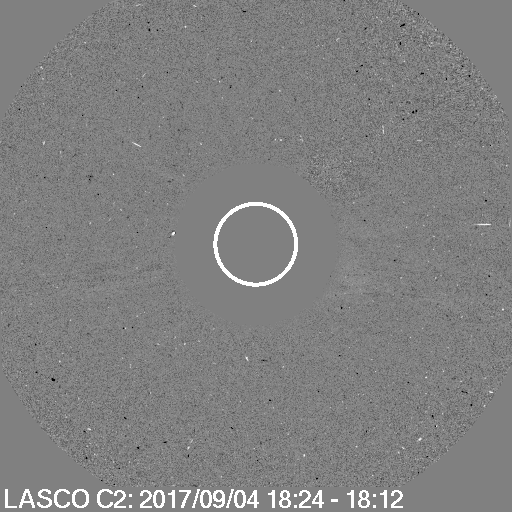Earth-directed coronal mass ejection
Tuesday, 5 September 2017 16:41 UTC

Sunspot region 2673 really delivered yesterday with multiple M-class events and a complex earth-directed eruption that is likely going to arrive tomorrow! Keep on reading to find out more!
Eleven M-class solar flares thus far. Not bad for a sunspot region which only consisted of one single spot a few days ago. While most of these solar flares weren't eruptive, we are going to pick out two solar flares that resulted in a complex eruption yesterday (4 September) between about 18:30 UTC and 21:00 UTC. The show began with a very slow rising M1.7 solar flare (R1-minor) that was quickly followed by an M5.5 (R2-moderate) solar flare that peaked at 20:33 UTC. Check out yesterday's X-ray chart here for more details.
Two coronal mass ejections were flung into space in this time frame. First a slow eruption directed a bit to the south-west but this event was quickly followed by a much faster coronal mass ejection that left the Sun at about 1.500km/s and needless to say this second coronal mass ejection engulfed the first coronal mass ejection. This second coronal mass ejection was also much wider as it formed an asymmetrical full halo coronal mass ejection as we can clearly see on the SOHO/LASCO imagery below. If you look closely you can clearly see the two separate eruptions.

⇧ Animation: SOHO/LASCO C2 and C3 coronagraph animation showing the earth-directed eruptions.
If we are picky we must say that the cloud of solar plasma isn't perfectly earth-directed as the bulk does seem to head a bit to the south-west but we are confident that we are going to see a solid impact at Earth. Even the low-energy protons as measured by ACE EPAM show a distinct increase which is an excellent sign that a big cloud of solar plasma is on it's way to Earth.
Factoring in the launch speed of this plasma cloud along with the ambient solar wind speeds at Earth at the moment we think that the plasma cloud could arrive at Earth tomorrow (6 September) in the afternoon, UTC time of course. An impact time around 16:00 UTC with a plus/minus of 6 hours seems very reasonable.
Solar wind speeds at Earth close to 700km/s seem to be a real possibility and if the plasma cloud consists of a strong southward pointing interplanetary magnetic field (Bz) we are looking at good possibilities for a moderate G2 geomagnetic storm to develop, possibly even reaching the strong G3 level.
Can we expect more solar flares?
Good question! Sunspot region 2673 remains by far the most complex sunspot region on the earth-facing solar disk as it keeps its Beta-Gamma-Delta magnetic layout. It hasn't been producing any M-class solar flares in the past couple of hours but the region remains incredibly complex and should be monitored for more flaring activity.


It keeps multiple delta structures and in the middle we have two massive umbrae cores of opposite polarities within the same penumbral area, almost touching each other. A magnetic layout which could produce serious fire works! Do not let this ''silence'' fool you. More M-class solar flares (R1-R2) are very likely and even an X-class event (R3) can not be ruled out at this stage! The region is now rotating out of view but an eruption within the next 24 hours will likely still have an earth-directed component!
Thank you for reading this article! Did you have any trouble with the technical terms used in this article? Our help section is the place to be where you can find in-depth articles, a FAQ and a list with common abbreviations. Still puzzled? Just post on our forum where we will help you the best we can!
Latest news
Latest forum messages
Support SpaceWeatherLive.com!
A lot of people come to SpaceWeatherLive to follow the Sun's activity or if there is aurora to be seen, but with more traffic comes higher server costs. Consider a donation if you enjoy SpaceWeatherLive so we can keep the website online!

Space weather facts
| Last X-flare | 2025/03/28 | X1.1 |
| Last M-flare | 2025/03/31 | M1.2 |
| Last geomagnetic storm | 2025/03/27 | Kp5 (G1) |
| Spotless days | |
|---|---|
| Last spotless day | 2022/06/08 |
| Monthly mean Sunspot Number | |
|---|---|
| February 2025 | 154.6 +17.6 |
| March 2025 | 127 -27.6 |
| Last 30 days | 127 -25.7 |


